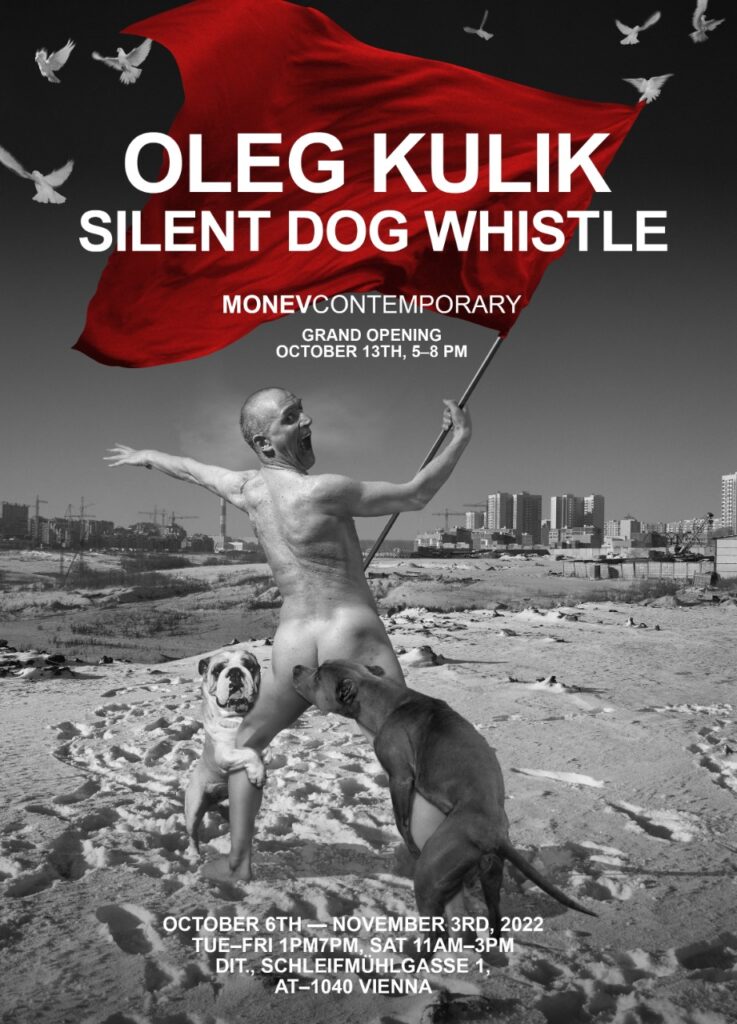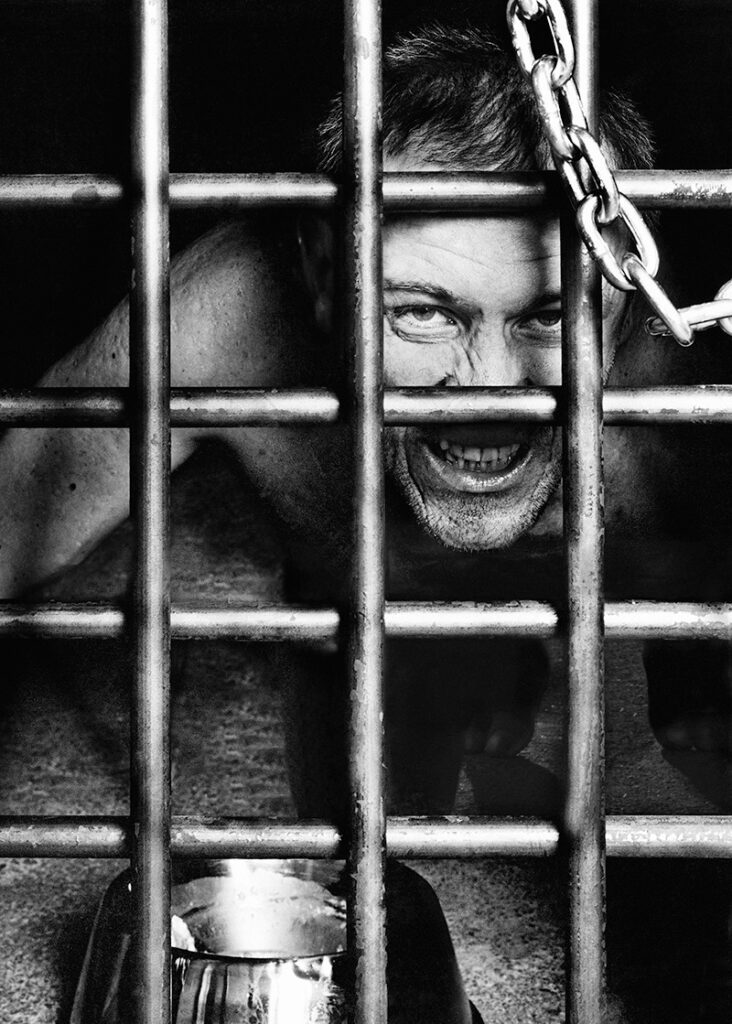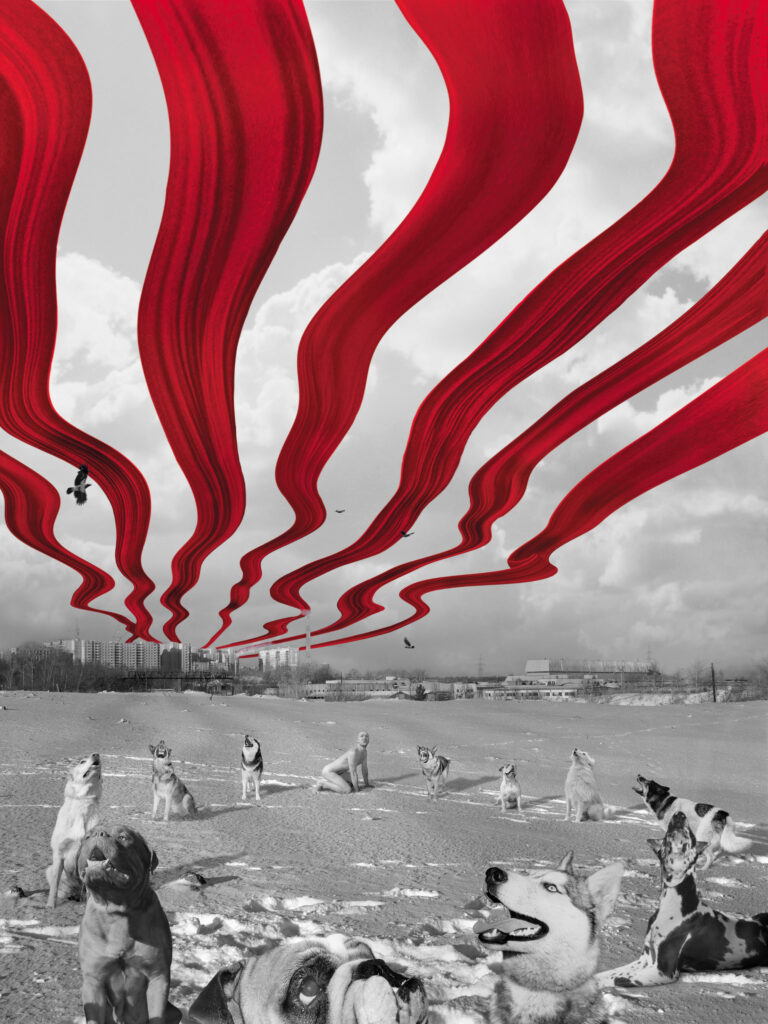
MONEVCONTEMPORARY @ D.I.T. Schleifmühlgasse 1, 1040 Vienna
Duration: 06.10.-03.11
Opening hours: Mon – Sat, each 13 – 19 h
Grand Opening: 13.10. 5-8PM
From 6.10 to 3.11 the exhibition Silent Dog Whistle, realized by MONEV CONTEMPORARY, presents works by the Ukrainian-born Russian performance artist Oleg Kulik. The multi-layered meaning of the Dog Whistle is explored through the work of Kulik’s iconic figure, who is counted as a part of the Moscow Actionists.
Kulik engages with the powerful meaning of these terms and the concepts behind them by moving along the boundary between human and animal, deconstructing any pre-set boundaries between his own body and the animal body.
The performances that took place in the Moscow Actionism group were radical and provocative. His work is more current than ever, the urgency and zeitgeist of Oleg Kulik testify to its quality and sharpness.

Some messages can be received through whispers. Some get carried out through waves, just as the sounds of a dog whistle, silent for humans, heard by the dog. An animal, domesticated for centuries by the human kind and captured in an anthropocentric hierarchy. Sometimes, however, information can be spoken out loud, having an ambiguous meaning wrapped in a code and still unheard for some. Sounds, words, language, used as a political weapon to control and suppress parts of our society.
The term ‘dog whistle’ consists of such ambiguous notions. It can be the obvious. A whistle, as canines are able to perceive much higher frequencies. Thereby, such a whistle is part of the hierarchical relationship of human kind and dog. Accompanied by its original narrative, a more figurative sense of the term can be found. Related to our capitalist society, the term is also used in a political context. It refers to a coding embedded in racism, sexism, oppression. Just as the election campaigns of the White Mans Party in the 60s were characterized by racially coded dog whistling, to this day such threatening frequencies hurl back and forth. Silent Dog Whistle makes you think about such phenomena, reflecting about current events.
While some whisper about dark secrets, others have their mouths sewn shut. Silenced, marginalized, deprived of freedom. In Silent Dog Whistle MONEV CONTEMPORARY organized an exhibitionbyperformance artist Oleg Kulik, who addresses the strong meaning of those terms and concepts as he interferes at the border of humanity and animalism, deconstructing all given boundaries between his own body – the artists body – and the dogs body. The Ukrainian-born Russian artist investigates the limits within the relationship between humans and animals, for instance by pretending to perform sexual acts with various animals. Therefore, he creates multiple transgressions that suggest an analogy between humans and dogs. With his gestures he breaks taboos and demythologizes all seriousness.
Why have I stood on all fours? Why have I become a dog?
My standing on hands and knees is a conscious falling-out of a human horizon, connected with a feeling of the end of anthropocentrism, with a crisis of not just contemporary art but contemporary culture on the whole. (Kulik 2002, p. 349)
Kulik uses the interaction with the dog, or rather himself as the human-dog, as a way of shocking the post-communist population. Brutality, sadomasochism and abject acts in the public sphere of performance were his tools seen in the exhibition with works from the 1990s. The performances that took place in the group of the Moscow Actionism were radical and provocative. In the post-communist state an open form of critical art emerged, which completely separated itself from the possibilities of previously state-sponsored and ideologically shaped art. It entirely contradicted the traditions of the Soviet Union. The protest of Kulik and his contemporaries was directed against materialism and the commercialization of art in the discourse of the post-communist situation, in which the free market suddenly gained immense significance within the cultural field.

Silent Dog Whistle shows works by Oleg Kulik from 1994/1993 to 1998, exhibiting both photographic works and documentary photographs of various performances, thus making accessible a wide range of his artistic work. In several of his best-known performances, Kulik assumed the role of a dog: he barked, howled, bit visitors and defecated on the ground while on a leash, causing scandals. Other works seen in the exhibition are staged photographs, like Russian Series or Family, in which he reduces conflicting questions to the level of absurdity. In Your Candidate Kulik on the other hand he takes his concept of a political Animal-Party a step further. The photographic series Memento Mori is one of his first works, where he shifted the focus away from his person to other subjects. In this case Kulik shows close ups of dead monkeys preserved in the museum, with the title already suggesting it refers to the remembrance of death. The photographs let the viewer reflect on how we as humans use the corpses without their will, for any desired purpose.
With his works he provoked the audience and many times triggered police operations. 25 years after his last show “Fourth Dimension”(in collaboration with Mila Bredikhina) in Vienna at the Secession his work is more relevant than ever, the urgency and zeitgeist of Oleg Kulik testify to his quality and sharpness.
Literature: Why have I bitten a Man? An Open Letter by Oleg Kulik, in: Primary Documents. A Sourcebook for Eastern and Central European Art since the 1950s, hg. v. Laura Hoptman und Tomas Pospiszyl, New York 2002, p. 344-361.
